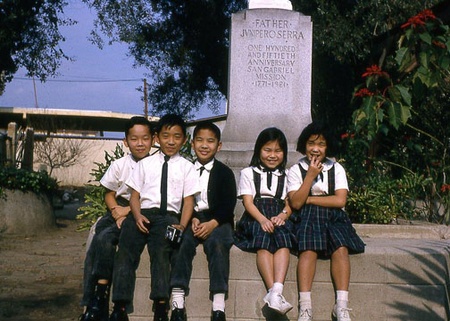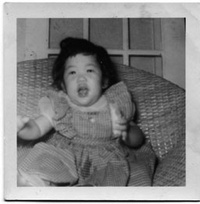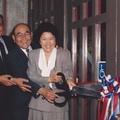I’ve been driven by food all my life. My chubbiness, which I’ve never been able to shake all my life, can be attributed to the fact that I love food and have eaten considerably more than what a 4'9" girl should. In fact, in many of the candid photos I have from my childhood, you’ll likely see me with food clutched in my hand. Alan Kunihiro, one of my Maryknoll classmates sent me a great shot of a group of us on a field trip to the San Gabriel Mission. Of course, I’m the one with the cookie.

Photo courtesy of Allen Kunihiro. c. 1967 From L to R: Jason Ito, Paul Kosako, Allen Kunihiro, Sue Horinouchi, Janice Tanaka
Those who went to Maryknoll during the ‘60s will undoubtedly recall the lunch served in the auditorium. It was the highlight of my day. Who can forget the pinkish-brown hard plastic plate divided into 3 segments topped with an odd assortment of meals. When I became a little more aware and educated, I imagined this was probably what it was like for our parents in camp.
Some kids were picky eaters, but I never missed a meal, whether it was the bland mashed potatoes topped with weird gravy made from hamburger bits, the egg foo young, or the faux tempura hot dog entrée. Of course, the nuns did daily inspections to make sure we ate everything on our plates. “Think of all the starving children in China!” they would say as they reprimanded kids who tried to trash uneaten food. Some of my classmates figured out that they could stuff their empty milk cartons with food to escape getting scolded.
To be fair, it wasn’t all bad. I liked the leftover corned beef and cabbage served right after the annual St. Patrick’s Day Celebration. I remember our Pastor, Father McKillop, and how we all became Irish for one day. We wore green shamrocks and proudly sang “When Irish Eyes Are Smiling” with gusto. The entrée came with a mysterious green Jell-O salad and Sister Bernadette’s yummy apple pie.
Dinner at home was routine. My mother had a job at the Bank of America, a job she held for 25 years. She had little time to make interesting meals. She was a rudimentary cook, at best, and because Dad refused to eat chicken, we rotated though a minimal menu of large vats of spaghetti and rice, bara bara hamburger and rice, meatballs with Campbell’s Mushroom Soup and rice, teriyaki hot dogs and rice, and an occasional chewy flank steak with bell peppers and rice. On Catholic fish Fridays, Mom would pan-fry a jar of oysters with rice, lemon, and shoyu or sometimes grandma would buy saba sushi from Mr. Teramoto’s fish truck. Most meals came with the same side dish: kim chi and either broccoli, string beans, or cauliflower with shoyu and mayo.
Then, Elsie Kikuchi, my classmate at Maryknoll, rescued me from my culinary doldrums. I remember it like it was yesterday. We were in 6th grade. My father was going to pick me up after school. I wouldn’t be boarding the early school bus to go home. Maryknoll was in J-Town and I was a Westsider, meaning, I lived west of downtown in the Seinan district. Along with the other kids from Uptown and Crenshaw, we would hop on the first bus out immediately after school and be the first to be picked up each morning. But since my father was going to pick me up, I had time to kill. So Elsie and I made plans to hang out. She had told me to bring 35 cents with me and she would take me on a food adventure. I think Elsie suspected I loved to eat.

Photo taken by teacher. c. 1964. From front to back: Elsie Kikuchi 3rd girl, Janice Tanaka, 4th girl.
It was a warm spring afternoon when we came out of class. “Are you ready?” asked Elsie. I nodded eagerly. I tied my dark blue wool sweater around my waist like I meant business. We were wearing our uniforms—the round collared white shirt, a bow tie, and plaid pleated skirt. We set off down the sidewalk with quick, eager steps befitting a couple of short girls.
Elsie was thin with bangs across her forehead and straight hair. She and I shared the lack of a growth spurt. Our camaraderie strengthened as girls always stuck in the front at the school assembly, that daily ritual when every student lined up by height each morning to listen to the twins, Janet and Janice, play a slightly off key rendition of ”Taps” on their bugles courtesy of the Maryknoll Drum and Bugle Corps. Then we’d all recite the pledge of allegiance and march in an orderly fashion to class.
Elsie was always smiling. I always thought she was wise beyond her years because she often imparted, what I thought at the time were practical life lessons. Over lunch once, we discussed dogs versus cats. I belonged to a “dog” family. My mother hated cats. She claimed they almost smothered her by sitting on her chest when she was young. I grew up scared of cats, thinking they would suck the life out of me. Elsie allayed my fears as only Elsie could. She convinced me that cats don’t suffocate people. In fact, they were cute and cuddly and the ideal pet. Indeed, I ended up adopting cats later in life. I’m totally a “cat” person now.
Elsie led me confidently out of the school grounds on Hewitt, west to First Street. Unsure about the surroundings, I made sure I was right beside her. We passed Kato’s Sewing, the Koyasan Buddhist Temple, and other industrial buildings. If anyone knew Little Tokyo well, it was Elsie. Her father was a well known entertainer in Little Tokyo. As a Japanese speaking Master of Ceremonies and musician, Mr. Kikuchi often performed at concerts and singing shows at Koyasan on the weekends. Elsie mentioned to me that he was well known for being a female impersonator and would often dress in up in a woman’s kimono as part of his act.

c. 1968 Performance at Maryknoll, Photo by Tomeo Hanami. L to R: Elsie Kikuchi, Janice Tanaka, Grace Tanaka and unknown shakuhachi player
Our first stop was Mikawaya, where there were rows and rows of manju in shiny glass cases. I was mesmerized by the variety and types: from the bean-filled kurimanju that my grandmother used to receive as gifts from her Ikebana students, to the more colorful mochi that I learned later is properly called mochigashi. My eyes fastened onto a pretty pink and white one. I thought it might taste like strawberries. Fifteen cents later and much to my disappointment, I discovered it tasted like a hunk of sweet mochi. It was softer than the kind we ate on New Year’s Day that was served with from shoyu-and-sugar sauce, but otherwise there was nothing remarkable. Over time I acquired a taste for the kinako covered green mochigashi with the beans, which ultimately became my favorite.
Our next stop was Lem’s Chinese restaurant on First Street. The entry roof slanted down as you walked in the door. We ceremoniously sat in a booth. Elsie ordered a chashu bao for 20 cents. I’d never seen one before. It was steamy, soft, and delicious, but still a bun, and then I was treated to an unexpected surprise—warm, tasty, and perfectly seasoned chunks of chashu lay buried like a treasure in the heart of the bun. Needless to say, I’ve been hooked on bao since.
With our tummies full, we walked back to the playground at Maryknoll to wait for our rides home. The eating escapade solidified my ties to J-Town forever. And I have to thank Elsie Kikuchi for it.
© 2012 Janice D. Tanaka





